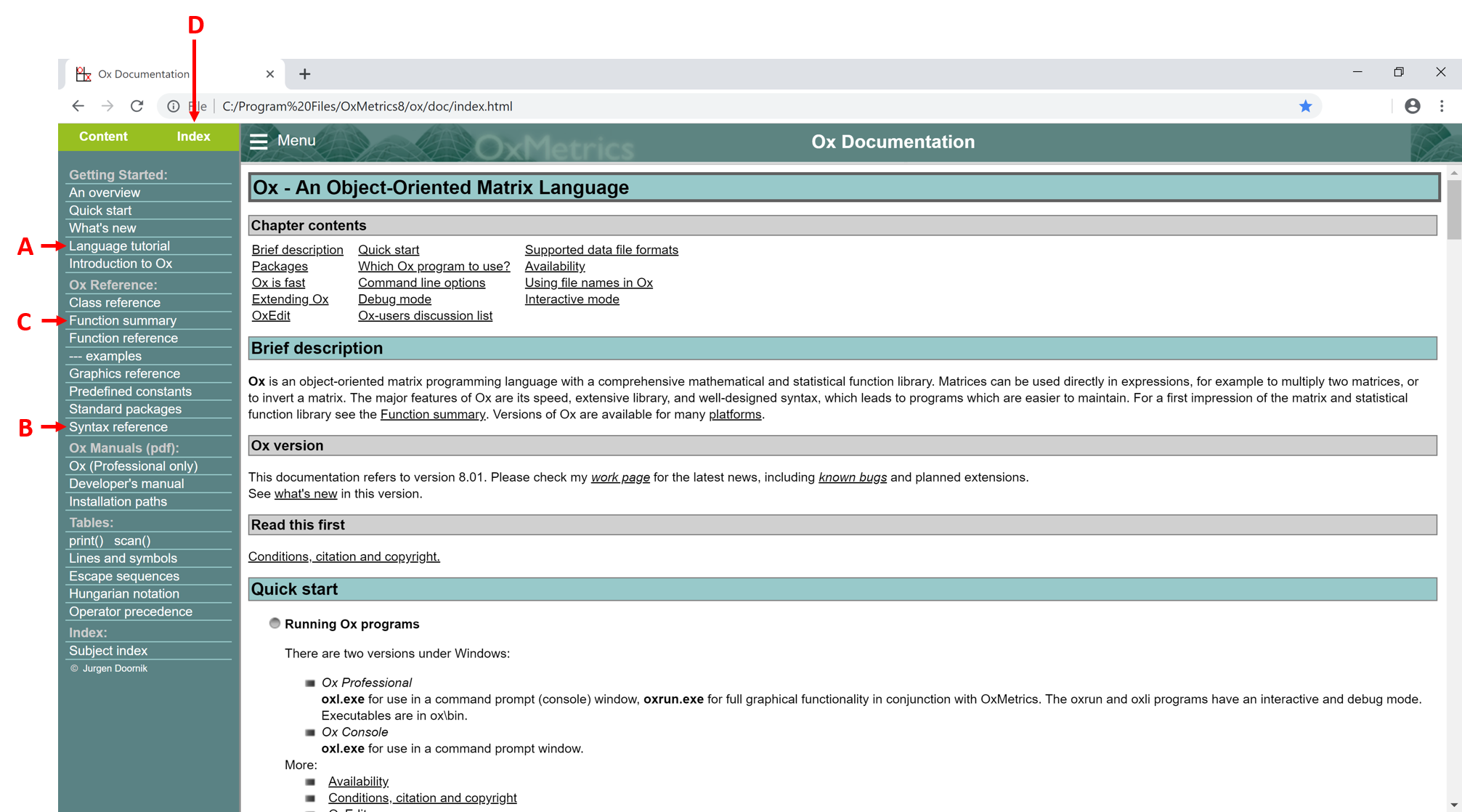The same exact documentation is available online at http://www.doornik.com/ox/. Here is that page:

- A. Language Tutorial
- If you click on this menu item you will see a brief summary of Ox programming. These notes cover the same material but assume less knowledge of programming and programming languages in general. If you already have programmed in some other language, the Ox language tutorial is a quick way to get going. If you have not programmed you will probably find it less useful at this point.
- B. Syntax Reference
- The syntax reference is a complete version of the language tutorial. It covers all elements of Ox syntax in a logical order. It is most useful as a reference guide once you can do some things in Ox but want to do more or if Ox is not behaving the way you expect. These notes attempt to cover the same ground but are not designed as a reference while debugging a program or trying to find a way to do something new in Ox.
- C. Function Summary (and reference and examples)
- One of the key aspects of Ox is the fact that it is designed for econometrics and economics in general. Much of this utility comes from its library of functions. For example, find the entry in the function summary for the Ox function
sqr(). Here is an edited version of what you actually see:sqr(const ma); sqrt(const ma); ma in: arithmetic type Return value sqrt returns the square root of the elements of ma, of double or matrix type. sqr returns the square of the elements of ma. If the input to sqr is a double or matrix, the return type is a double or matrix. If the input is an integer, the return type is integer unless the result would overflow in integer computation. In that case the return type is double in order to represent the result. ExampleOne job you have is to learn how to read this kind of description of a function so that you can use it in your own Ox program to do things you want. Some built-in Ox functions are pretty simple and self-explanatory likeprint()orsqr(). Others are complex and to use them correctly you have to read the description carefully and absorb what it is saying. - Most functions also have example code that you get by clicking on
Example
. Again, here is an edited version of what shows up if you do that for thesqr()descriptions:#include "oxstd.oxh" main() { print( sqr(<2,3>) ); } produces 4.0000 9.0000The real example shows output ofsqrt()and compares it to the power operator too. This part of the example shows that if you take the square of a vector it will return the vector of squares. The description above shows that you send any arithmetic type tosqr(), including integers, real numbers, vectors and matrices. - Notice that the description writes
sqrt(const ma). The thing you send tosqr()is called an argument just like in math we would say $x$ is the argument of $f(x)$. The namemais given so that the Ox description can talk about the argument sent tosqr(). It can be very confusing for a new programmer to realize that the name in the description does not affect how you use a built-in function likesqr(). Theconsttag beforemain the description is also confusing. What it means is that the function is not going to do anything to what you send to it. That is, it is treated as a constant. Why that matters and what it means is not something to explain now. (Arguments to Ox functions are almost always treated as constant). But hopefully it makes sense that writingsqr(x)should not changexitself but simply return (or equal) the square of x.
Exercises
max() and rerun it so that you understand what max() does. Once you feel comfortable, compare what max() does with maxc(), which is a different function. Compare the output of max() and maxc() when both are sent the matrix < 1, 2, 3; 4, 5, 6>.
Kronecker product(a matrix operation not needed in this class, just used as an example for finding help.)